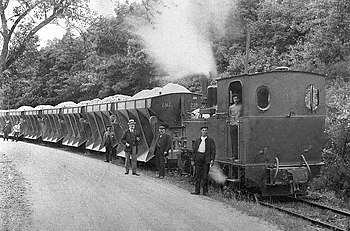Leppetalbahn
| Engelskirchen – Marienheide | |||||||||||||||||||||||||||||||||||||||||||||||||||||||||||||||||||||||||||||
|---|---|---|---|---|---|---|---|---|---|---|---|---|---|---|---|---|---|---|---|---|---|---|---|---|---|---|---|---|---|---|---|---|---|---|---|---|---|---|---|---|---|---|---|---|---|---|---|---|---|---|---|---|---|---|---|---|---|---|---|---|---|---|---|---|---|---|---|---|---|---|---|---|---|---|---|---|---|
|
Train of the Leppetalbahn near Niederwette
| |||||||||||||||||||||||||||||||||||||||||||||||||||||||||||||||||||||||||||||
| Course book section (DB) : | last 240b | ||||||||||||||||||||||||||||||||||||||||||||||||||||||||||||||||||||||||||||
| Route length: | 18.4 km | ||||||||||||||||||||||||||||||||||||||||||||||||||||||||||||||||||||||||||||
| Gauge : | 1000 mm ( meter gauge ) | ||||||||||||||||||||||||||||||||||||||||||||||||||||||||||||||||||||||||||||
| Maximum slope : | 20 ‰ | ||||||||||||||||||||||||||||||||||||||||||||||||||||||||||||||||||||||||||||
|
|||||||||||||||||||||||||||||||||||||||||||||||||||||||||||||||||||||||||||||
The Leppetalbahn , also Engelskirchen – Marienheider Railway , abbreviated EME , was an 18.5 km long, single-track small railway line in meter gauge from Engelskirchen to Marienheide in the Oberbergischer Kreis in North Rhine-Westphalia .
history
On September 30, 1895, the district of Gummersbach was granted the concession for a small railway Engelskirchen – Marienheide. This commissioned the company Lenz & Co. with the construction of the line. Due to the difficult geographical conditions, only one narrow-gauge railway could be built in the Leppetal , which could adapt better to the tight curves, and it was also cheaper to build. The railway was built with a gauge of 1,000 millimeters. The steam locomotives of the Leppetalbahn were popularly called the fiery Elias . The route was largely laid to the side of the road, which certainly led to the early exit from the railway, as the roads could be widened after the closure.
The quarry industry in the Leppetal had a major interest in the construction of the narrow-gauge railway and no longer wanted to bring its products to the state railway stations in Engelskirchen or Marienheide in horse-drawn vehicles. Above all, greywacke from quarries between Neuremscheid and Kaiserau was transported in large quantities. In Engelskirchen there was a fall ramp from which unloading was carried out directly into the regular-gauge wagons. However, the transport volumes were heavily dependent on the construction industry. Instead of 200,000 t in 1913, only 30,000 t were transported in 1933. But the ironmongery industry also contributed to the volume of traffic.
After the opening on September 5, 1897, the Lenz subsidiary Westdeutsche Eisenbahn-Gesellschaft took over management , which in 1925 transferred it to Vereinigte Kleinbahnen AG . From August 1, 1956, it was finally transferred to Oberbergische Verkehrsgesellschaft AG (OVAG), in which the Oberbergische Kreis has a stake.
In the Second World War , the Leppetalbahn, especially the vehicle fleet, was badly damaged during the air raids on Engelskirchen . After the war ended in 1945, however, operations were resumed.
Passenger traffic was stopped on September 8, 1949 after a parallel bus line (the current OVAG line 308) was set up.
The traffic to the small iron industry in the Leppetal increased due to the increased armaments production at the end of the 1930s. This is why roller stands have been used since 1940 , for which a roller stand pit was built in Engelskirchen. The roll stands were coupled directly to the locomotive using a special coupling rod with a welded-on tow hook, which was only used in this form on this railway. For this, the central buffer plates had two holes into which the pins of the coupling rod were inserted. Since June 30, 1950, freight traffic has only been restricted to the Engelskirchen – Berghausen section. The largest customer was Schmidt & Clemens with their own sidings. From October 1, 1952, the railway was included in the DB freight tariff. On March 31, 1958, this remaining line was also closed and the tracks removed.
In the terrain, the route of the former railway can still be seen partially. Its entire width is used in Kaiserau as a parking lot for an industrial area.
vehicles
Two three-axle wet steam locomotives ( Jung , 1897) and one four-axle superheated steam locomotive were used. The locomotives were scrapped in 1958.
literature
- Gerd Wolff: German small and private railways. Volume 4: North Rhine-Westphalia. Southern part. EK-Verlag, Freiburg 1997, ISBN 978-3-88255660-5 , pp. 299-308.
- Sascha Koch, Horst Kowalski and others: Railways in Oberberg and the history of the Dieringhausen depot. Galunder Verlag, Nümbrecht 2005, ISBN 978-3-89909050-5 .
- Lothar Riedel: The narrow-gauge railway Engelskirchen-Marienheide. Kenning Verlag, Nordhorn 1997, ISBN 978-3-92758780-9 .

